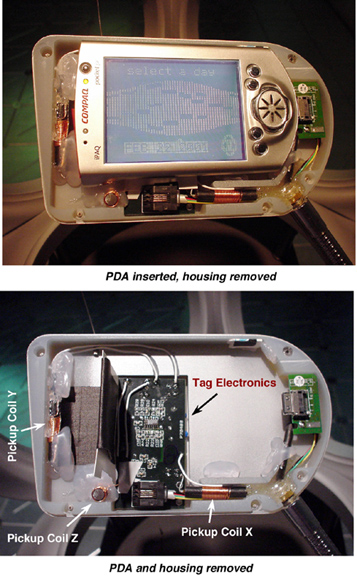Sensor Systems for Atmosphere

The Atmosphere installation visualizes a large cloud of information on a wide presentation screen that can be manipulated by three handheld devices, each mounted on a plinth within the gallery space. The visitor holds one of the devices and physically moves it within a designated area, thereby manipulating the information presented both on the screen and the larger projection. A simple active magnetic tracking system was developed to track the position and orientation of the handheld device. Signals are magnetically coupled into these tags from a triad of transmitting coils on each plinth. The magnitude of the coupling is inversely proportional to the distance from the coils and proportional to the sine of the angle between the tag and the normal of the coil. Using the magnitude of the recovered signal from each tag for each coil, it is possible to calculate both the position and (unsigned) orientation of the device relative to the reference frame formed by the coils.
Atmosphere is a collaboration of the Media Lab's Aesthetics and Computation group, the Responsive Environments group and Steelcase Inc. Atmosphere was installed at the Museum of Modern Art (MOMA) in New York during the Workspheres design exhibition of 2001. A webpage for the full project can be found here and a poster version of this information can be found here.
A video clip can be linked here (Quicktime 5.2 Meg) that shows first a Workspheres station in action with full graphics, then shows the matrix of 9 detected tracker signals (3 receive and 3 transmit coils) as the PDA is moved about, then shows the resultant 3 composite signals (the quadrature sum of the 3 pickup signals for each transmit coil).
A paper with a section describing Atmosphere's active magnetic tracker in more detail can be downloaded below:
Electromagnetic Tagging for Electronic Music Interfaces, Paradiso, J.A., Pardue, L.S., Hsiao, K, Benbasat, A.Y., Journal of New Music Research, Vol. 32, No. 4, December 2003, pp. 395-409.
 Return to the Responsive Environments Project Page
Return to the Responsive Environments Project Page

Joe Paradiso

